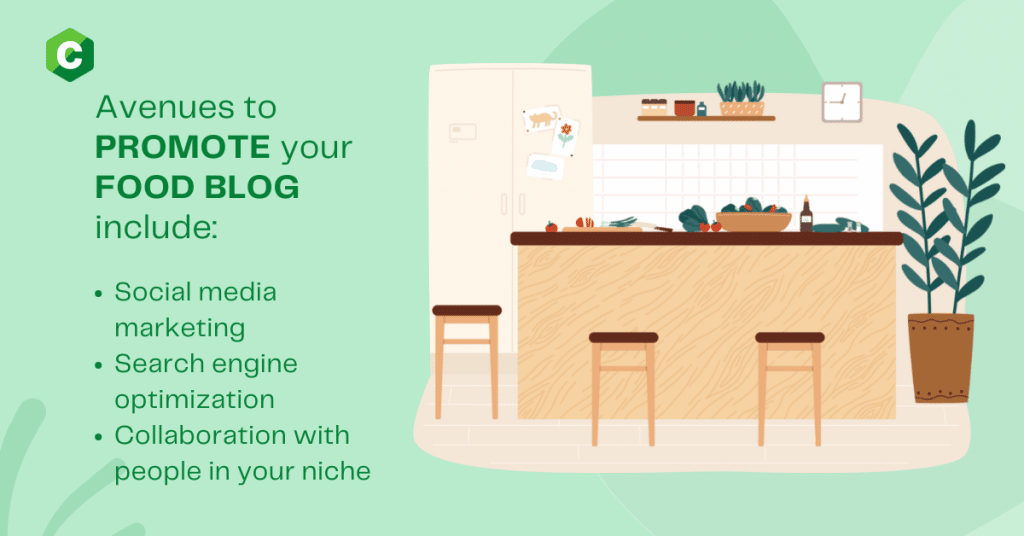If you’re passionate about food and cooking, starting a food blog could be an exciting and rewarding experience to share your culinary creations with the world. But where do you begin? In this article on how to start a food blog, we’ll walk you through all the basic steps you’ll need to get your food blog up and running.
Before we start, you may wonder why food blogging is so important. Food blogging is a quickly growing trend and an excellent way to connect with people worldwide with a common interest. And what better way for you to finally join the food community and share your expertise with your readers?
Here are several steps to get you started!
How To Start a Food Blog: The Steps
So whether you’re looking for a new twist or an old favourite or want to try something completely new, you’ll find it on a food blog. So how exactly do you get started? It may be a challenging activity, but by following the steps below, you will be well to the top with your food blog.
Identifying your niche
It’s no secret that the internet is a vast and sprawling place. With billions of people sharing billions of pieces of content daily, making your voice heard can be challenging. That’s why finding your niche is so important.
For example, when you start a food blog, you’re not just competing with other food blogs. You’re competing with every website on the Internet that has anything to do with food. And when you focus on a specific niche within the food industry– say, healthy vegan recipes – you immediately have a much smaller competition pool. And that gives you a better chance to stand out and build an audience.
Find a suitable blog name
Choosing a good name is one of the most important aspects of starting a food blog. Not only will it help you to attract readers, but it will also make it easier for people to find your blog when they’re searching for information on the web.
Here are some tips for choosing a great food blog name:
- Keep it short and sweet. A shorter name is easier to remember and harder to misspell.
- Make it unique. Think about what makes your blog special and try to reflect that in your name.
- Be creative. A creative name will help you stand out from the hundreds of other food blogs.
- Consider using keyword-rich phrases. If you want people to be able to find your blog efficiently, using keywords in your name can be helpful.
- Use domain name tools to check availability. Once you’ve come up with a few potential names, use a domain name tool like GoDaddy or NameCheap to check availability and see if the domains are available for purchase.

Picking a blogging platform
Knowing which is right for you can be challenging with many different blogging platforms. However, taking the time to research your options will help you choose a platform that best suits your needs. You’ll want to look for a venue with built-in features that make it easy to promote your blogs, such as social media integration and email subscription options.
- WordPress is an excellent platform for food blogs because it is easy to use and has a wide range of features. Setting up a WordPress site is simple, and there are a variety of themes and plugins available to customize your blog. In addition, WordPress is free and easy to monetize, so you can start earning money from your blog without investment.
- Blogger is easy to use and offers a variety of templates and themes to choose from, specifically for food blogs. And because it’s so popular, there are also lots of resources and tutorials available if you need any help getting started.
- Tumblr is perfect for food bloggers who want to create a visually stunning blog. The platform makes it easy to post photos and videos, and you can also follow other bloggers to get inspiration for your blog.
Get a reliable web hosting provider
As you find out how to start a food blog, one of the first things you’ll find is that you need to get a reliable web hosting service. A good web host will provide you with everything you need to get your site up and running, including WordPress hosting, domain registration, and email services. They’ll also offer 24/7 customer support in case you have any questions or run into any problems.
Most web hosts offer a variety of plans, so you can choose the one that meets your needs. For example, starting a food blog, you’ll probably want a plan that includes enough storage space and bandwidth to accommodate high-quality photos and videos.
Launch your blog on WordPress
WordPress is an excellent option if you’re thinking about starting a food blog. The platform is easy to use and offers a wide range of customization options, so you can create a unique space that reflects your brand. Plus, there’s no need to worry about hosting or design fees because it is free.
To start, you must create a WordPress account and choose a theme for your site. Once you’ve done that, you can start adding content – photos, recipes, blog posts, etc. – and build an audience. Of course, it takes time and effort to grow a successful blog, but with perseverance and dedication, anything is possible.
Choose a blog theme
The theme will determine your site’s overall look and feel, so choosing something that reflects your style and personality is essential. There are a few things to remember when selecting one; consider the content you want to include on your blog. Do you want to focus on recipes, or do you want to write more general posts about food and cooking? It will help you narrow down your choices. Lastly, look at the design of other food blogs you admire.
With a good idea of what you would like, here are excellent food blog themes you should look at:
- Foodica’s homepage features a large banner where you can showcase your latest recipes and sections for featured posts and recent comments. The theme also includes social media integration so readers can share your content with friends.
- Cookley is free and designed to be visually appealing and easy to use so that you can focus on your content’s importance. It’s perfect for food bloggers of all levels, from beginners to seasoned pros. So whether you’re just starting or blogging for years, Cookley is an excellent easy-to-learn theme you can implement in your food blog.
- Foodie Pro has beautiful recipe layouts and a built-in Instagram feed. It is also highly customizable, so you can make your blog stand out from the crowd. There are many different color schemes and layout options to choose from, so you can create a unique look for your blog that reflects your style.
Add plugins to your blog
Plugins are like add-ons for your website, and they can help you do everything from adding social media buttons to optimizing your site for search engines. While thousands of plugins are available, only a few are essential for food blogs. Here are four must-have plugins for any food blog:
- WP Recipe Maker comes with a built-in recipe editor that makes it easy to create and edit recipes. The editor includes a range of features that make it easy to add ingredients, instructions, photos, and other information to your recipes—allowing you to easily create beautiful recipes with pictures, nutrition information, and easy-to-follow instructions.
- Pinterest Sidebar Widget allows you to add a Pinterest-style widget to your sidebar, making it easy for visitors to browse your content and find recipes they’re interested in. And it includes all the features you need to make your blog look professional and inviting, from recipe cards to nutritional information.
- Yoast SEO allows you to optimize your website for specific keywords. For example, starting a blog about healthy vegan recipes, you can use Yoast SEO to ensure your website comes up when people search for “healthy vegan recipes.” It also controls how your website appears on search engine results pages and includes features like social media integration and Google Analytics integration.
- Recipe card can help you organize your recipes, making it easy for readers to find the necessary ingredients and instructions. Plus, with a Recipe Card, you can add photos and videos of your dishes, making your blog more visually appealing.

Come up with a content plan
Planning your content is one of the most important aspects when learning how to start a food blog. By taking the time to plan your content, you can ensure that your blog is organized, informative, and engaging. Additionally, it can help you save time in the long run and clearly understand what you need to write about before you start writing. As a result, you will be less likely to get bogged down in the writing process and more likely to produce high-quality content regularly.
Promoting Your Food Blog
By taking the time to promote your food blog, you’ll be able to reach more readers and share your passion for all things culinary. Below are the various ways to go about promoting your food blog:
Social media marketing
That means creating content (like posts, pictures, and videos) that will interest your followers and get them to interact with your blog. It will allow you to interact with the people who use social media platforms already interested in food. They might follow cooking shows, share recipes with friends, or drool over food pictures. The best platforms for food bloggers are usually Facebook, Instagram, Twitter, and Pinterest.
Search Engine Optimization
SEO stands for search engine optimization, and there are a few different ways you can use it to promote your blog. For example, you can use SEO to choose the right keywords and phrases on your website and in your blog posts. This will help potential readers find your blog when they search for topics you write about. You can also use SEO to link your blog to other websites and blogs, which can help increase traffic to your site.
Collaboration with other people in your niche
Networking with other bloggers and influencers can be highly beneficial when promoting your food blog. Connecting with others in the food blogging community allows you to share ideas, collaborate on projects, and encourage each other’s work. In addition, working with other food bloggers can help you to broaden your reach and connect with a larger audience.

Monetizing Your Food Blog
Let’s face it; food blogging is a competitive field. There are thousands of food blogs, and only a handful are making money. If you want to be one of the successful ones, you need to find ways to generate revenue from your blog. Here are several ways you can monetize your blog:
Affiliate marketing
Affiliate marketing is a commission-based marketing arrangement whereby you promote and sell products on behalf of a merchant. When a sale is made, you get to earn a commission. When choosing an affiliate marketing program, it’s essential to consider your audience and your goals. For example, if you have a blog focusing on healthy eating, you might look for affiliate programs selling healthy food products. So, as you figure out how to start a food blog, consider looking into affiliate marketing.
Selling ad space
If you’re monetizing your food blog, selling ad space is one way. It can be a great way to bring in some extra income. There are a few ways to go about it. First, you can reach out to companies or brands that you think would be a good fit for your blog. You can also join an advertising network like Google Adsense, which will place ads on your site for you. Finally, you can also work with an advertising agency specializing in food blogs.
Brand sponsorships
To collaborate with brands, you must have a solid social media presence and a well-trafficked blog. You also need to be able to demonstrate your value as an influencer. Once you’ve established yourself as an influencer, reaching out to brands and pitching yourself as a collaborator is the next step. If you can secure a brand sponsorship, you’ll be compensated for featuring the brand’s products on your blog or social media channels.
Publish and sell cookbooks
For many food bloggers, publishing and selling cookbooks is a great way to monetize their passion. In addition to the obvious benefit of generating revenue, cookbooks also help to raise your profile and build your brand. If you can produce a quality cookbook that appeals to your target audience, it can be a valuable marketing tool, helping you attract new readers and followers. Additionally, cookbooks can be a fun and rewarding creative project, allowing you to share your love of food with the world uniquely and tangibly.

Final Thoughts!
So there you have it! A comprehensive guide on how to start a food blog. Follow each step keenly, and you will be well on your way to writing unique food content that your readers will love.
We sincerely hope that this guide has been of great help and inspiration. If you need any help along the way, don’t hesitate to contact Contact Clerks – we would be more than happy to assist you with starting your very own successful food blog. In the meantime, keep cooking up unique dishes and sharing them with the world!
There are a few different ways that food bloggers can get paid. They include:
Advertising and sponsorship.
Writing sponsored posts.
Affiliate marketing.
Yes, it is. Food blogging might be the perfect outlet for you if you love to cook and experiment with new recipes and are excited about sharing your culinary creations with the world.
Recipes from cookbooks or other published sources.
Develop your recipes from scratch.
Rely on the generosity of your readers.
Recreation from restaurants of family recipes.

